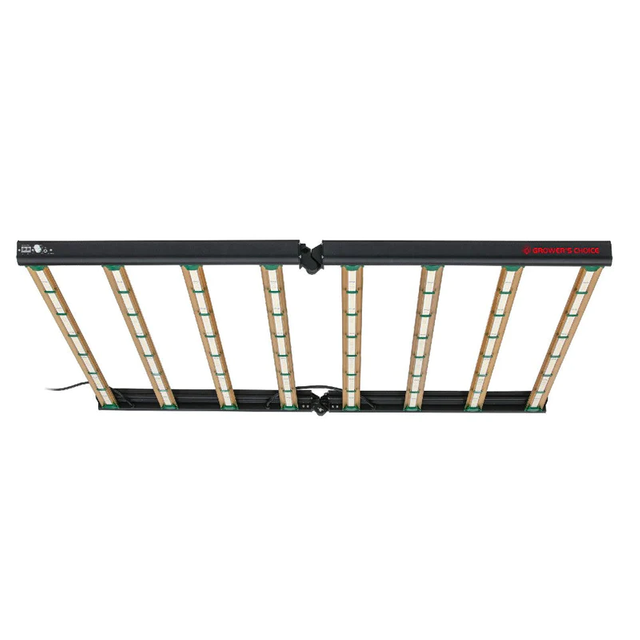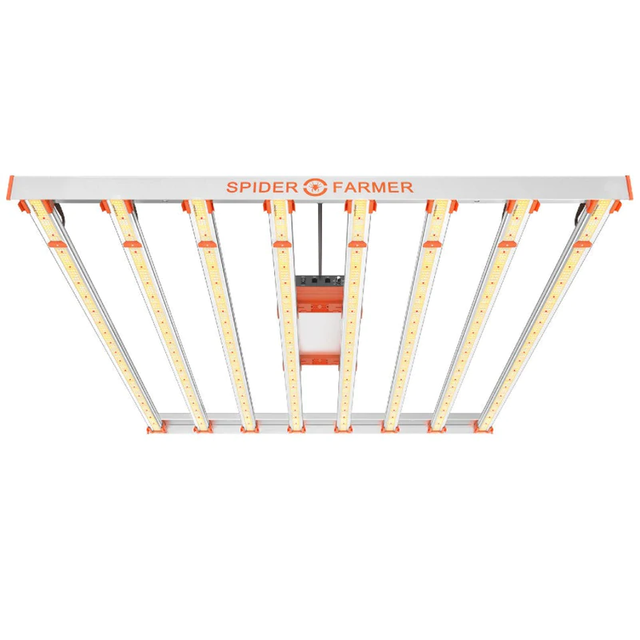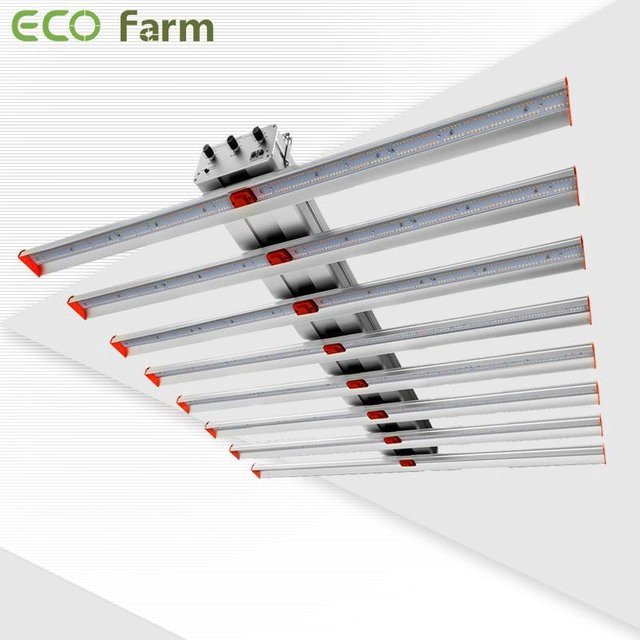Growing plants indoors needs a lot of care, with particular attention to light and water for your plants. Proper lighting is of paramount importance if you want to grow plants inside your home. Growing indoors has several advantages, resulting in indoor-grown plants having better quality than those grown outdoors. This is a primary reason why plants grown indoors is used for recreational and medicinal purposes.
There are different types of grow lights that you can use to nurture your plants. With the right grow light fixtures, you will be able to improve the THC level of your plants, which enhances the quality of your plants. Growing plants indoors also means you get to control the lighting according to your needs instead of just relying on natural light.
Why Use LED Grow Lights For Plants?
EFFICIENCY
While they are only now gaining traction in the growing world, LED grow lights for plants are the most effective grow light available to growers today. The moderate 75 percent more power than regular grow lights and, in turn, keep your power consumption low and your power bills affordable.
LESS HEAT
Some of the Best LEDs for plants are popular for their ability to produce very low levels of heat. Because they have a significantly lower heat output, you don’t need to use fans and ventilators to maintain low temperatures in your grow room. You also don’t need to worry about fires as you would if you had HID lights. Even better, LED lights feel cool to the touch even after hours of running.
MORE DURABLE
Many growers pick the LED grow light option for durability. Usually, the durability can be attributed to LED lights’ lack of filaments to burn. An LED light can give you over 50,000 to 60,000 hours of light, which is impressive compared to the 2000–3000 hour-lifespan of HID lights.
ECO Farm ECOZ PRO 1000W Samsung 301H Chips LED Grow Light
Features:
The ECO Farm LED Grow Light delivers growers and indoor gardeners the ability to stimulate pre-visibility, boost yields and increase quality all season long. The grow light utilizes uses the best parts, Top Bin Samsung LM301H & Os-ram chips, and brand drivers, To achieve higher efficiency and longer service life; The light intensity is higher, the light attenuation is smaller, and the lumen and PAR value are better than ordinary LED. It enables you to obtain a 30% higher output than HPS. The number of ECOZ PRO 1000W chips is 3480PCS. ECOZ PRO industry’s top light efficiency -2.9 μmol/j; This durably constructed LED grow light delivers smooth, even light over the canopy. This kind of growth lamp is a full-period lighting solution suitable for all growth environments (including humid environments), and is an ideal choice for greenhouse or indoor lighting.
Grower’s Choice ROI-E900 LED Grow Light

Features:
This Grower’s Choice LED grow light boosts up to 1,000 watts of supercharged photon output. Using Growers Choice’s proven PAR formula, the ROI-E900 utilizes our unique PAR formula and 3k full-phase spectral radiance into a 4'x5' growing space, producing tremendous light output and canopy coverage. Designed to accommodate commercial growers with wider tables or trays, the ROI-E900 offers the greatest potential for extended coverage, penetration and premium yields. The ROI-E900 will give you more power and more flowers!
Spider Farmer G860W Full Spectrum LED Grow Light

Features:
This Spider Farmer LED Grow Light features an even peripheral PPFD score for even coverage, ensuring maximum light per plant. The elongated light bar design also ensures a more even distribution of light, reaching all edges and corners. The strip grow light design and the aluminium heatsink on the back contribute to better airflow and good heat dissipation. The G860W Garden Light features a detachable driver and 6.56" long power cord to reduce ambient heat in the grow space for longer life. The LED diodes are coated with water repellent, so they are not afraid of a wet environment. Dimming daisy-chaining allows you to link up to 60 G680W Series grow lights together — dimming multiple lights simultaneously. Widely used in commercial cultivation, vertical farming, home gardens, home cultivation, CO2 systems and hydroponics.
Factors to Consider When Buying a Large LED Plant Light
Actual Wattage
This is the actual amount of electricity the fixture will use. Three of the lights featured here always use the same wattage, while the other one has a range. That’s because it gives you some control over the spectrum.
During the vegetative stage of growth, for example, plants don’t need as much light as they do during flowering. A fixture that lets you turn off LEDs (or dial back their intensity) when they are not needed will save you money in electricity costs.
Spectrum
There are two factors to consider here: the color of the light and how customizable it is.
1. White LEDs vs. Colored LEDs
And depending on whom you ask, fixtures using only full-spectrum white LEDs are either amazing or completely worthless.
Here are the two sides:
Pro White Light
Proponents of all-white LED grow lights say their spectrum is the most natural, since it is very similar to the sun. It basically gives you the same light as an HPS bulb combined with a metal-halide bulb. In other words: an HPS spectrum with additional blue light.
HPS light has proven to work well and plants obviously love sunlight, so it only makes sense that white LED light is the best way to go. And it does work, just like the HPS and MH light it replaces.
And white light has one more advantage — one that is very important to some people. Your plants look natural under white light, so it is much easier to inspect them and to notice any discolorations, etc. This can be quite difficult under pink light.
Against White Light
Opponents of white light point out that it’s mostly made up of green and yellow light, which is used only minimally by plants and thus mostly goes to waste. This is fine for the sun, since it is an unlimited supply of free light. But when YOU’RE footing the bill, wouldn’t it be better to not pay for all that wasted light?
2. Customizable Spectrum
Some lights have separate modes for veg and bloom and some, give you complete control over the spectrum.
The advantage of this is a lower electricity bill. Plants don’t need as much light during vegging as they do during flowering and they need even less during cloning. Being able to dial back the amount of light means you use less power.
But there’s a flip side. Some of those savings are offset by a longer grow cycle. When you change the color spectrum mid-grow, plants get a shock and suffer from growth stalling for up to two weeks. Switching modes on an LED light will not cause an overly long period of stalled growth, but you can count on a few days’ delay.
During this time, you will have to pay for electricity to run the lights and for nutrients to feed the plants. This won’t make up for the savings you get from switching the color spectrum, but a shorter grow time is very important to some. Furthermore, fixtures with only one mode are obviously much easier to operate — just turn it on and forget about it.
Light Output
1000w LED fixtures generally have an output equal to 900 watts of HPS light, despite what many manufacturers claim.
For our ratings, we gave 4 stars to the fixtures whose intensity is about equal to 900 HPS watts and 5 stars for an intensity better than a 1000 watt HPS bulb.
Canopy Penetration
Again, almost all manufacturers claim their LED light penetrates as deeply below the canopy as HPS light, but that is rarely the case.
Coverage Area
This is the area in feet that the light will cover during flowering. During vegging, they can cover an additional foot or two in length and width. So a light that covers 4 by 4 feet during flowering will cover 5 by 5 or 6 by 6 feet during vegging.
Conclusion
When growing plants indoors, you have to decide what takes top priority. Do you care about your energy bills, the environment, secrecy, or efficiency?
If you’re looking for discretion, LED grow lights is probably the best grow light for indoor plants available.
Different options work best for different solutions, so pick the one that’s right for you and work to its advantages. Once you have selected the right light for your needs, you can start growing plants. After choosing the soil type, your fertilizer preferences, and a few other things, of course!

Some of those savings are offset by a longer growth cycle.
Downvoting a post can decrease pending rewards and make it less visible. Common reasons:
Submit